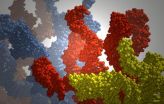(Press-News.org) A new study from the University of Washington reported obese children are at increased mortality risk in later years following primary liver transplantation (LT). Pediatric patients who are thin or severely thin, experience an early mortality risk—within the first year post-LT. Details of the ten-year survival analysis are published in the November issue of Liver Transplantation, a peer-reviewed journal of the American Association for the Study of Liver Diseases (AASLD).
Childhood obesity is a serious public health concern worldwide. According to the World Health Organization (WHO), the prevalence of obesity has been increasing at an alarming rate, with 22 million children under the age of five worldwide who are overweight. In the U.S., the National Center for Health Statistics estimates that 17% of children between the ages of 2 and 19 years old are overweight or obese.
"Controversies exist regarding the mortality of patients undergoing liver transplantation at the extremes of body mass index (BMI), and in pediatric patients weight is typically the only factor considered in survival analysis," explained lead study author André Dick, M.D., from Seattle Children's Hospital and the University of Washington. "Our study is the largest thus far to report on the impact of pre-transplant BMI on post liver transplant survival in the pediatric population." Prior studies in adult populations have shown there to be a negative impact on post transplantation survival for LT patients with extreme BMIs.
For the present study, researchers reviewed data from the Organ Procurement and Transplantation Network (OPTN) and found that 7,942 patients less than 18 years of age (who had full BMI data) underwent primary liver transplantation between 1987 and 2007. Using the WHO BMI criteria, the authors categorized patients as severely thin, thin, normal weight, overweight, or obese. During the study period 61% of patients were at normal weight.
Results indicate that children who were thin or severely thin had a significantly lower survival (84%) at one year compared to the survival (89%) of children in the normal and overweight groups. Researchers found no significant difference in survival during the first year after transplantation for obese pediatric patients. However, by the twelfth year following LT, those in the obese group had significantly lower survival (72%) than the survival (77%) of normal weight or overweight pediatric patients.
The authors observed that obesity had a significantly negative impact on pediatric patient survival more than five years after LT. They speculate post metabolic syndrome (PTMS) could contribute to the late morbidity and mortality due to the time it takes to develop long-term obesity-related conditions such as diabetes, hypertension, and hyperlipidemia. Moreover, long-term use of immunosuppressive therapy following transplantation, which while improving patient survival, can exacerbate the effects of PTMS. "Further research is needed to determine the optimal immunosuppressive regimen that will lessen the effects of PTMS," concluded Dr. Dick. "Pre- and post-transplant identification of malnourished or obese pediatric patients, along with optimization of their modifiable risk factors will help to best use scarce donor organs and maximize patient survival."
INFORMATION:
This study is published in the October issue of the Liver Transplantation. Media wishing to receive a PDF of this article may contact healthnews@wiley.com.
Full citation: "The Impact of Obesity on Children Undergoing Liver Transplantation." André A.S. Dick, James D. Perkins, Austin L. Spitzer, Oliver B. Lao, Patrick J. Healey, Jorge D. Reyes. Liver Transplantation; Published Online: August 27, 2010 (DOI: 10.1002/lt.22162); Print Issue Date: November 2010. http://onlinelibrary.wiley.com/doi/10.1002/lt.22162/abstract
About the Journal
Liver Transplantation. is published by Wiley-Blackwell on behalf of the American Association for the Study of Liver Diseases and the International Liver Transplantation Society . Since the first application of liver transplantation in a clinical situation was reported more than twenty years ago, there has been a great deal of growth in this field and more is anticipated. As an official publication of the AALSD and the ILTS, Liver Transplantation. delivers current, peer-reviewed articles on surgical techniques, clinical investigations and drug research — the information necessary to keep abreast of this evolving specialty. For more information, please visit Liver Transplantation.
About Wiley-Blackwell
Wiley-Blackwell is the international scientific, technical, medical, and scholarly publishing business of John Wiley & Sons, with strengths in every major academic and professional field and partnerships with many of the world's leading societies. Wiley-Blackwell publishes nearly 1,500 peer-reviewed journals and 1,500+ new books annually in print and online, as well as databases, major reference works and laboratory protocols. For more information, please visit www.wileyblackwell.com or our new online platform, Wiley Online Library (wileyonlinelibrary.com), one of the world's most extensive multidisciplinary collections of online resources, covering life, health, social and physical sciences, and humanities.
Media Advisory
What: The 61st Annual Meeting of the American Association for the Study of Liver Diseases (AASLD)
Founded in 1950, AASLD is the leading organization of scientists and healthcare professionals committed to preventing and curing liver disease. AASLD has grown into an international society responsible for all aspects of hepatology, and the annual meeting attracts 8,500 physicians, surgeons, researchers, and allied health professionals from around the world.
The Liver Meeting® is the premier meeting in the science and practice of hepatology, including the latest findings on new drugs, novel treatments, and the results from pilot and multicenter studies.
When: October 30 – November 2, 2010
Where:
Hynes Convention Center
900 Boylston Street
Boston, Massachusetts
Contact: Please contact Ann Haran at 703-299-9766 or aharan@aasld.org to obtain a press pass for this event.
END
The researchers, in partnership with the Cancer Council, Australia, studied 12,618 food advertisements from 11 countries and found that 67 per cent endorsed unhealthy food. The research builds on a previous study at Liverpool which revealed that children would consume twice as many calories from snacks after watching food adverts compared to after viewing advertising for toys and games.
The research reveals that Germany, Spain and Greece have the highest frequency of adverts promoting unhealthy foods during children's peak viewing time, compared to other European countries ...
Researchers from North Carolina State University have found a way to optimize the development of DNA self-assembling materials, which hold promise for technologies ranging from drug delivery to molecular sensors. The key to the advance is the discovery of the "Goldilocks" length for DNA strands used in self-assembly – not too long, not too short, but just right.
DNA strands contain genetic coding that will form bonds with another strand that contains a unique sequence of complementary genes. By coating a material with a specific DNA layer, that material will then seek ...
(Boston) A team of researchers from Boston University's Center for Regenerative Medicine and the Pulmonary Center have generated 100 new lines of human induced pluripotent stem cells (iPSC) from individuals with lung diseases, including cystic fibrosis and emphysema. The new stem cell lines could possibly lead to new treatments for these debilitating diseases. The findings, which appear in the current issue of Stem Cells, demonstrate the first time lung disease-specific iPSC have been created in a lab.
iPSCs are derived by reprogramming adult cells into a primitive stem ...
More than 251 million years ago, at the end of the Permian period, Earth almost became a lifeless planet. Around 90 percent of all living species disappeared then, in what scientists have called "The Great Dying."
Thomas J. Algeo, has spent much of the past decade investigating the chemical evidence buried in rocks formed during this major extinction. The University of Cincinnati professor of geology has worked with a team of scientific colleagues to understand the ancient catastrophe. Algeo will present his latest findings at the annual meeting of the Geological Society ...
A robust geoscience program will draw thousands of curious minds to the Colorado Convention Center in Denver for the 122nd Annual Meeting & Exposition of the Geological Society of America, Oct. 31 to Nov. 3. More than 3,700 technical presentations will illuminate geological and integrative science research of international, national and regional interest. Among the papers presented by University of Cincinnati faculty and students at the Geological Society of America annual meeting are:
China Anomalies Add To Permian Extinction Understanding
Our understanding of global ...
PHILADELPHIA - A recently identified immune cell that directs other cells to fight infection plays a critical role in regulating the immune system in both health and disease. Researchers from the University of Pennsylvania School of Medicine have discovered how a stimulatory molecule and a protein found on the membrane of another immune cell make T helper 17 cells multi-taskers of sorts. Th17 cells protect the body against infection and cancer, but are also culprits in some autoimmune diseases and out-of-control, cancerous cell growth.
This new understanding that Th17 ...
With Election Day right around the corner, political egos are on full display. One might even think that possessing a "big ego" is a prerequisite for success in politics, or in any position of leadership. High achievers–CEO's, top athletes, rock stars, prominent surgeons, or scientists–often seem to be well endowed in ego.
But when does a "healthy ego" cross the line into unhealthy territory? Where is the line between confident, positive self-image and grandiose self-importance, which might signal a personality disorder or other psychiatric illness? More fundamentally, ...
The virus, called enterovirus 71, is closely related to poliovirus, and was first detected in California in the 1960s. Since then the virus has spread across Asia, affecting mostly children and some adults. Serious cases of the disease can include neurological disorders such as meningitis, paralysis and encephalitis.
As a result of a global health campaign, polioviruses have almost been eradicated in many areas of the world. Enterovirus 71, however, has caused major outbreaks of hand, foot, and mouth disease and it is still unclear why such a high number of cases occur ...
Ancient gardens are the stuff of legend, from the Garden of Eden to the Hanging Gardens of Babylon. Now researchers at Tel Aviv University, in collaboration with Heidelberg University in Germany, have uncovered an ancient royal garden at the site of Ramat Rachel near Jerusalem, and are leading the first full-scale excavation of this type of archaeological site anywhere in the pre-Hellenistic Levant.
According to Prof. Oded Lipschits and graduate student Boaz Gross of Tel Aviv University's Department of Archaeology, this dig is an unparalleled look into the structure ...
Millions of Medicare recipients have been forcibly reassigned to different prescription drug plans because Part D reimbursements to insurance companies covering low-income patients are lower than the actual costs incurred, according to a study released online today by Health Affairs. The report describes how a system designed to encourage competition and to subsidize care for low-income Medicare patients instead has led companies to raise their premiums in an effort to price themselves out of the low-income segment of the Part D market.
"These insufficient payments create ...


